【Matplotlib】数据可视化实例分析
来源:互联网 发布:python compile 编辑:程序博客网 时间:2024/05/16 12:42
数据可视化实例分析
作者:白宁超
2017年7月19日09:09:07
摘要:数据可视化主要旨在借助于图形化手段,清晰有效地传达与沟通信息。但是,这并不就意味着数据可视化就一定因为要实现其功能用途而令人感到枯燥乏味,或者是为了看上去绚丽多彩而显得极端复杂。为了有效地传达思想概念,美学形式与功能需要齐头并进,通过直观地传达关键的方面与特征,从而实现对于相当稀疏而又复杂的数据集的深入洞察。然而,设计人员往往并不能很好地把握设计与功能之间的平衡,从而创造出华而不实的数据可视化形式,无法达到其主要目的,也就是传达与沟通信息。数据可视化与信息图形、信息可视化、科学可视化以及统计图形密切相关。当前,在研究、教学和开发领域,数据可视化乃是一个极为活跃而又关键的方面。“数据可视化”这条术语实现了成熟的科学可视化领域与较年轻的信息可视化领域的统一。(本文原创编著,转载注明出处:数据可视化实例分析)
1 折线图的制作
1.1 需求描述
使用matplotlib绘制一个简单的折线图,在对其进行定制,以实现信息更加丰富的数据可视化,绘制(1,2,3,4,5)的平方折线图。
1.2 源码
#coding=utf-8import matplotlib as mplimport matplotlib.pyplot as pltimport pylab# 解决中文乱码问题mpl.rcParams['font.sans-serif']=['SimHei']mpl.rcParams['axes.unicode_minus']=False# squares = [1,35,43,3,56,7]input_values = [1,2,3,4,5]squares = [1,4,9,16,25]# 设置折线粗细plt.plot(input_values,squares,linewidth=5)# 设置标题和坐标轴plt.title('平方数图',fontsize=24)plt.xlabel('值',fontsize=14)plt.ylabel('平方值',fontsize=14)# 设置刻度大小plt.tick_params(axis='both',labelsize=14)plt.show()
1.3 生成结果
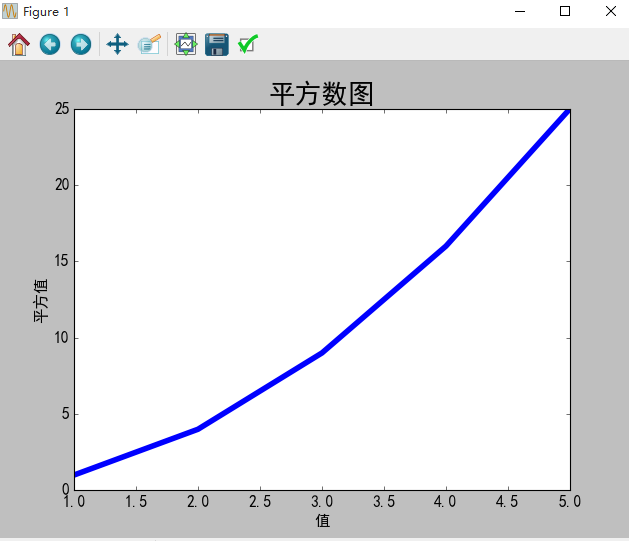
2 scatter()绘制散点图
2.1 需求描述
使用matplotlib绘制一个简单的散列点图,在对其进行定制,以实现信息更加丰富的数据可视化,绘制(1,2,3,4,5)的散点图。
2.2 源码
#coding=utf-8import matplotlib as mplimport matplotlib.pyplot as pltimport pylab# 解决中文乱码问题mpl.rcParams['font.sans-serif']=['SimHei']mpl.rcParams['axes.unicode_minus']=False# 设置散列点纵横坐标值x_values = [1,2,3,4,5]y_values = [1,4,9,16,25]# s设置散列点的大小,edgecolor='none'为删除数据点的轮廓plt.scatter(x_values,y_values,c='red',edgecolor='none',s=40)# 设置标题和坐标轴plt.title('平方数图',fontsize=24)plt.xlabel('值',fontsize=14)plt.ylabel('平方值',fontsize=14)# 设置刻度大小plt.tick_params(axis='both',which='major',labelsize=14)# 自动保存图表,参数2是剪裁掉多余空白区域plt.savefig('squares_plot.png',bbox_inches='tight')plt.show()
2.3 生成结果
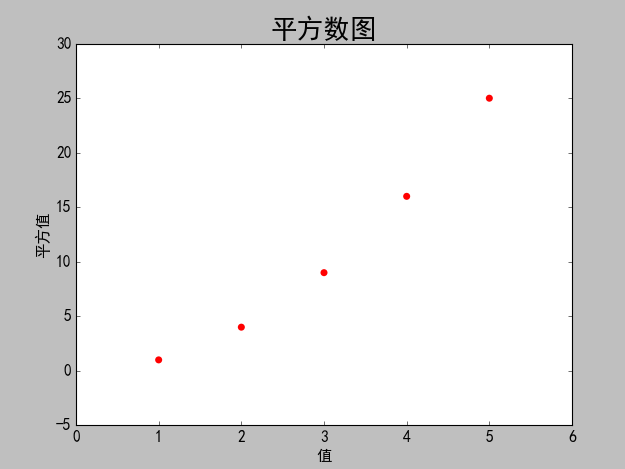
2.4 需求改进
使用matplotlib绘制一个简单的散列点图,在对其进行定制,以实现信息更加丰富的数据可视化,绘制1000个数的散点图。并自动统计数据的平方,自定义坐标轴
2.5 源码改进
#coding=utf-8import matplotlib as mplimport matplotlib.pyplot as pltimport pylab# 解决中文乱码问题mpl.rcParams['font.sans-serif']=['SimHei']mpl.rcParams['axes.unicode_minus']=False# 设置散列点纵横坐标值# x_values = [1,2,3,4,5]# y_values = [1,4,9,16,25]# 自动计算数据x_values = list(range(1,1001))y_values = [x**2 for x in x_values]# s设置散列点的大小,edgecolor='none'为删除数据点的轮廓# plt.scatter(x_values,y_values,c='red',edgecolor='none',s=40)# 自定义颜色c=(0,0.8,0.8)红绿蓝# plt.scatter(x_values,y_values,c=(0,0.8,0.8),edgecolor='none',s=40)# 设置颜色随y值变化而渐变plt.scatter(x_values,y_values,c=y_values,cmap=plt.cm.Reds,edgecolor='none',s=40)# 设置标题和坐标轴plt.title('平方数图',fontsize=24)plt.xlabel('值',fontsize=14)plt.ylabel('平方值',fontsize=14)#设置坐标轴的取值范围plt.axis([0,1100,0,1100000])# 设置刻度大小plt.tick_params(axis='both',which='major',labelsize=14)# 自动保存图表,参数2是剪裁掉多余空白区域plt.savefig('squares_plot.png',bbox_inches='tight')plt.show()
2.6 改进结果
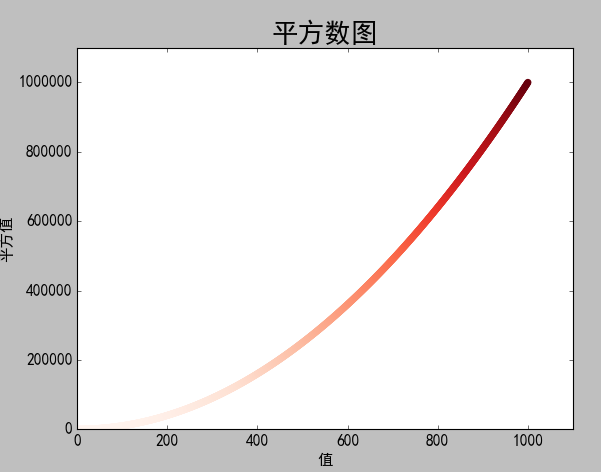
3 随机漫步图
3.1 需求描述
随机漫步是每次步行方向和步长都是随机的,没有明确的方向,结果由一系列随机决策决定的。本实例中random_walk决策步行的左右上下方向和步长的随机性,rw_visual是图形化展示。
3.2 源码
random_walk.py
from random import choiceclass RandomWalk(): '''一个生成随机漫步数据的类''' def __init__(self,num_points=5000): '''初始化随机漫步属性''' self.num_points = num_points self.x_values = [0] self.y_values = [0] def fill_walk(self): '''计算随机漫步包含的所有点''' while len(self.x_values)<self.num_points: # 决定前进方向及沿着该方向前进的距离 x_direction = choice([1,-1]) x_distance = choice([0,1,2,3,4]) x_step = x_direction*x_distance y_direction = choice([1,-1]) y_distance = choice([0,1,2,3,4]) y_step = y_direction*y_distance # 拒绝原地踏步 if x_step == 0 and y_step == 0: continue # 计算下一个点的x和y next_x = self.x_values[-1] + x_step next_y = self.y_values[-1] + y_step self.x_values.append(next_x) self.y_values.append(next_y)
rw_visual.py
#-*- coding: utf-8 -*-#coding=utf-8import matplotlib as mplimport matplotlib.pyplot as pltimport pylabfrom random_walk import RandomWalk# 解决中文乱码问题mpl.rcParams['font.sans-serif']=['SimHei']mpl.rcParams['axes.unicode_minus']=False# 创建RandomWalk实例rw = RandomWalk()rw.fill_walk()plt.figure(figsize=(10,6))point_numbers = list(range(rw.num_points))# 随着点数的增加渐变深红色plt.scatter(rw.x_values,rw.y_values,c=point_numbers,cmap=plt.cm.Reds,edgecolors='none',s=1)# 设置起始点和终点颜色plt.scatter(0,0,c='green',edgecolors='none',s=100)plt.scatter(rw.x_values[-1],rw.y_values[-1],c='blue',edgecolors='none',s=100)# 设置标题和纵横坐标plt.title('随机漫步图',fontsize=24)plt.xlabel('左右步数',fontsize=14)plt.ylabel('上下步数',fontsize=14)# 隐藏坐标轴plt.axes().get_xaxis().set_visible(False)plt.axes().get_yaxis().set_visible(False)plt.show()
3.3 生成结果
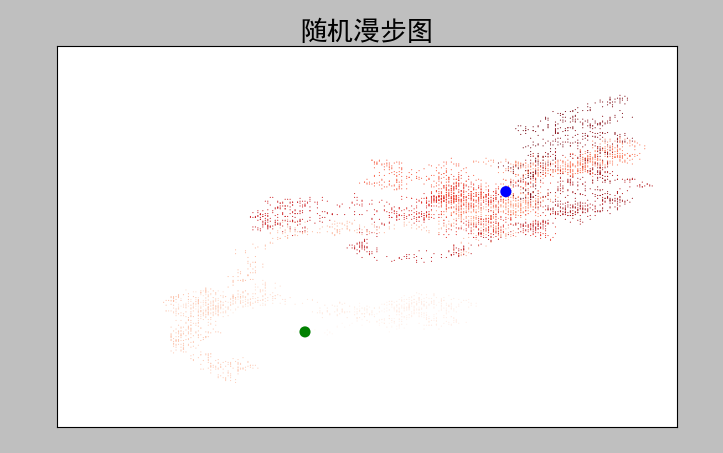
4 Pygal模拟掷骰子
4.1 需求描述
对掷骰子的结果进行分析,生成一个掷筛子的结果数据集并根据结果绘制出一个图形。
4.2 源码
Die类
import randomclass Die: """ 一个骰子类 """ def __init__(self, num_sides=6): self.num_sides = num_sides def roll(self): # 返回一个1和筛子面数之间的随机数 return random.randint(1, self.num_sides)
die_visual.py
#coding=utf-8from die import Dieimport pygalimport matplotlib as mpl# 解决中文乱码问题mpl.rcParams['font.sans-serif']=['SimHei']mpl.rcParams['axes.unicode_minus']=Falsedie1 = Die()die2 = Die()results = []for roll_num in range(1000): result =die1.roll()+die2.roll() results.append(result)# print(results)# 分析结果frequencies = []max_result = die1.num_sides+die2.num_sidesfor value in range(2,max_result+1): frequency = results.count(value) frequencies.append(frequency)print(frequencies)# 直方图hist = pygal.Bar()hist.title = '骰子投掷1000次各面结果统计图'hist.x_labels =[x for x in range(2,max_result+1)]hist.x_title ='结果'hist.y_title = '结果分布'hist.add('D6+D6',frequencies)hist.render_to_file('die_visual.svg')# hist.show()
4.3 生成结果
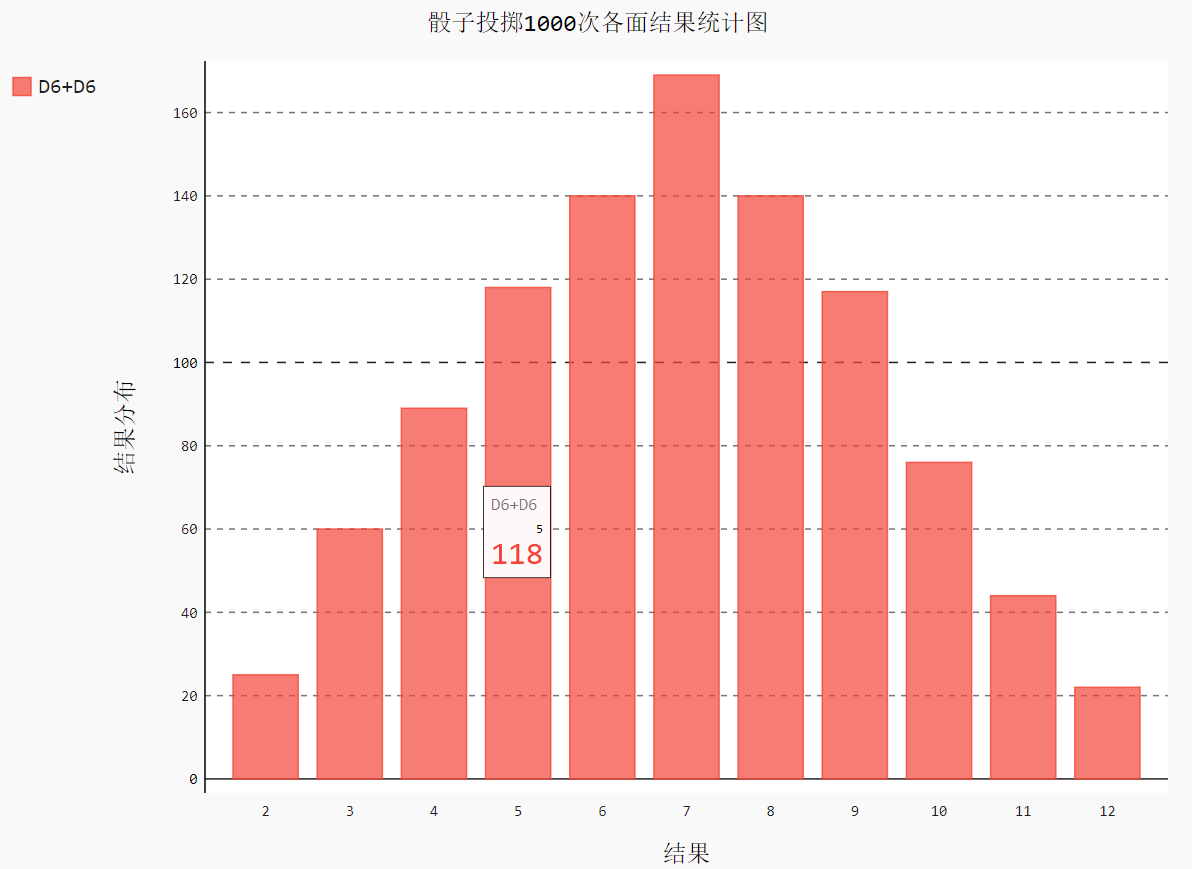
5 同时掷两个骰子
5.1 需求描述
对同时掷两个骰子的结果进行分析,生成一个掷筛子的结果数据集并根据结果绘制出一个图形。
5.2 源码
#conding=utf-8from die import Dieimport pygalimport matplotlib as mpl# 解决中文乱码问题mpl.rcParams['font.sans-serif']=['SimHei']mpl.rcParams['axes.unicode_minus']=Falsedie1 = Die()die2 = Die(10)results = []for roll_num in range(5000): result = die1.roll() + die2.roll() results.append(result)# print(results)# 分析结果frequencies = []max_result = die1.num_sides+die2.num_sidesfor value in range(2,max_result+1): frequency = results.count(value) frequencies.append(frequency)# print(frequencies)hist = pygal.Bar()hist.title = 'D6 和 D10 骰子5000次投掷的结果直方图'# hist.x_labels=['2','3','4','5','6','7','8','9','10','11','12','13','14','15','16']hist.x_labels=[x for x in range(2,max_result+1)]hist.x_title = 'Result'hist.y_title ='Frequency of Result'hist.add('D6 + D10',frequencies)hist.render_to_file('dice_visual.svg')
5. 生成结果

6 绘制气温图表
6.1 需求描述
对csv文件进行处理,提取并读取天气数据,绘制气温表,在图表中添加日期并绘制最高气温和最低气温的折线图,并对气温区域进行着色。
6.2 源码
csv文件中2014年7月部分数据信息


AKDT,Max TemperatureF,Mean TemperatureF,Min TemperatureF,Max Dew PointF,MeanDew PointF,Min DewpointF,Max Humidity, Mean Humidity, Min Humidity, Max Sea Level PressureIn, Mean Sea Level PressureIn, Min Sea Level PressureIn, Max VisibilityMiles, Mean VisibilityMiles, Min VisibilityMiles, Max Wind SpeedMPH, Mean Wind SpeedMPH, Max Gust SpeedMPH,PrecipitationIn, CloudCover, Events, WindDirDegrees2014-7-1,64,56,50,53,51,48,96,83,58,30.19,30.00,29.79,10,10,10,7,4,,0.00,7,,3372014-7-2,71,62,55,55,52,46,96,80,51,29.81,29.75,29.66,10,9,2,13,5,,0.14,7,Rain,3272014-7-3,64,58,53,55,53,51,97,85,72,29.88,29.86,29.81,10,10,8,15,4,,0.01,6,,2582014-7-4,59,56,52,52,51,50,96,88,75,29.91,29.89,29.87,10,9,2,9,2,,0.07,7,Rain,2552014-7-5,69,59,50,52,50,46,96,72,49,29.88,29.82,29.79,10,10,10,13,5,,0.00,6,,1102014-7-6,62,58,55,51,50,46,80,71,58,30.13,30.07,29.89,10,10,10,20,10,29,0.00,6,Rain,2132014-7-7,61,57,55,56,53,51,96,87,75,30.10,30.07,30.05,10,9,4,16,4,25,0.14,8,Rain,2112014-7-8,55,54,53,54,53,51,100,94,86,30.10,30.06,30.04,10,6,2,12,5,23,0.84,8,Rain,1592014-7-9,57,55,53,56,54,52,100,96,83,30.24,30.18,30.11,10,7,2,9,5,,0.13,8,Rain,2012014-7-10,61,56,53,53,52,51,100,90,75,30.23,30.17,30.03,10,8,2,8,3,,0.03,8,Rain,2152014-7-11,57,56,54,56,54,51,100,94,84,30.02,30.00,29.98,10,5,2,12,5,,1.28,8,Rain,2502014-7-12,59,56,55,58,56,55,100,97,93,30.18,30.06,29.99,10,6,2,15,7,26,0.32,8,Rain,2752014-7-13,57,56,55,58,56,55,100,98,94,30.25,30.22,30.18,10,5,1,8,4,,0.29,8,Rain,2912014-7-14,61,58,55,58,56,51,100,94,83,30.24,30.23,30.22,10,7,0,16,4,,0.01,8,Fog,3072014-7-15,64,58,55,53,51,48,93,78,64,30.27,30.25,30.24,10,10,10,17,12,,0.00,6,,3182014-7-16,61,56,52,51,49,47,89,76,64,30.27,30.23,30.16,10,10,10,15,6,,0.00,6,,2942014-7-17,59,55,51,52,50,48,93,84,75,30.16,30.04,29.82,10,10,6,9,3,,0.11,7,Rain,2322014-7-18,63,56,51,54,52,50,100,84,67,29.79,29.69,29.65,10,10,7,10,5,,0.05,6,Rain,2992014-7-19,60,57,54,55,53,51,97,88,75,29.91,29.82,29.68,10,9,2,9,2,,0.00,8,,2922014-7-20,57,55,52,54,52,50,94,89,77,29.92,29.87,29.78,10,8,2,13,4,,0.31,8,Rain,1552014-7-21,69,60,52,53,51,50,97,77,52,29.99,29.88,29.78,10,10,10,13,4,,0.00,5,,2972014-7-22,63,59,55,56,54,52,90,84,77,30.11,30.04,29.99,10,10,10,9,3,,0.00,6,Rain,2402014-7-23,62,58,55,54,52,50,87,80,72,30.10,30.03,29.96,10,10,10,8,3,,0.00,7,,2302014-7-24,59,57,54,54,52,51,94,84,78,29.95,29.91,29.89,10,9,3,17,4,28,0.06,8,Rain,2072014-7-25,57,55,53,55,53,51,100,92,81,29.91,29.87,29.83,10,8,2,13,3,,0.53,8,Rain,1412014-7-26,57,55,53,57,55,54,100,96,93,29.96,29.91,29.87,10,8,1,15,5,24,0.57,8,Rain,2162014-7-27,61,58,55,55,54,53,100,92,78,30.10,30.05,29.97,10,9,2,13,5,,0.30,8,Rain,2132014-7-28,59,56,53,57,54,51,97,94,90,30.06,30.00,29.96,10,8,2,9,3,,0.61,8,Rain,2612014-7-29,61,56,51,54,52,49,96,89,75,30.13,30.02,29.95,10,9,3,14,4,,0.25,6,Rain,1532014-7-30,61,57,54,55,53,52,97,88,78,30.31,30.23,30.14,10,10,8,8,4,,0.08,7,Rain,1602014-7-31,66,58,50,55,52,49,100,86,65,30.31,30.29,30.26,10,9,3,10,4,,0.00,3,,217 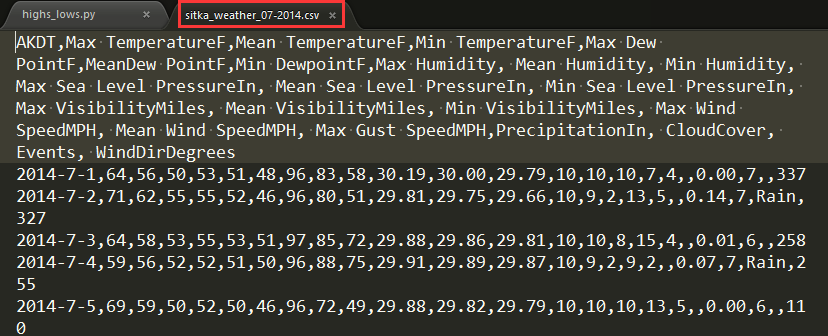
highs_lows.py文件信息
import csvfrom datetime import datetimefrom matplotlib import pyplot as pltimport matplotlib as mpl# 解决中文乱码问题mpl.rcParams['font.sans-serif']=['SimHei']mpl.rcParams['axes.unicode_minus']=False# Get dates, high, and low temperatures from file.filename = 'death_valley_2014.csv'with open(filename) as f: reader = csv.reader(f) header_row = next(reader) # print(header_row) # for index,column_header in enumerate(header_row): # print(index,column_header) dates, highs,lows = [],[], [] for row in reader: try: current_date = datetime.strptime(row[0], "%Y-%m-%d") high = int(row[1]) low = int(row[3]) except ValueError: # 处理 print(current_date, 'missing data') else: dates.append(current_date) highs.append(high) lows.append(low)# 汇制数据图形fig = plt.figure(dpi=120,figsize=(10,6))plt.plot(dates,highs,c='red',alpha=0.5)# alpha指定透明度plt.plot(dates,lows,c='blue',alpha=0.5)plt.fill_between(dates,highs,lows,facecolor='orange',alpha=0.1)#接收一个x值系列和y值系列,给图表区域着色#设置图形格式plt.title('2014年加利福尼亚死亡谷日气温最高最低图',fontsize=24)plt.xlabel('日(D)',fontsize=16)fig.autofmt_xdate() # 绘制斜体日期标签plt.ylabel('温度(F)',fontsize=16)plt.tick_params(axis='both',which='major',labelsize=16)# plt.axis([0,31,54,72]) # 自定义数轴起始刻度plt.savefig('highs_lows.png',bbox_inches='tight')plt.show()
6.3 生成结果
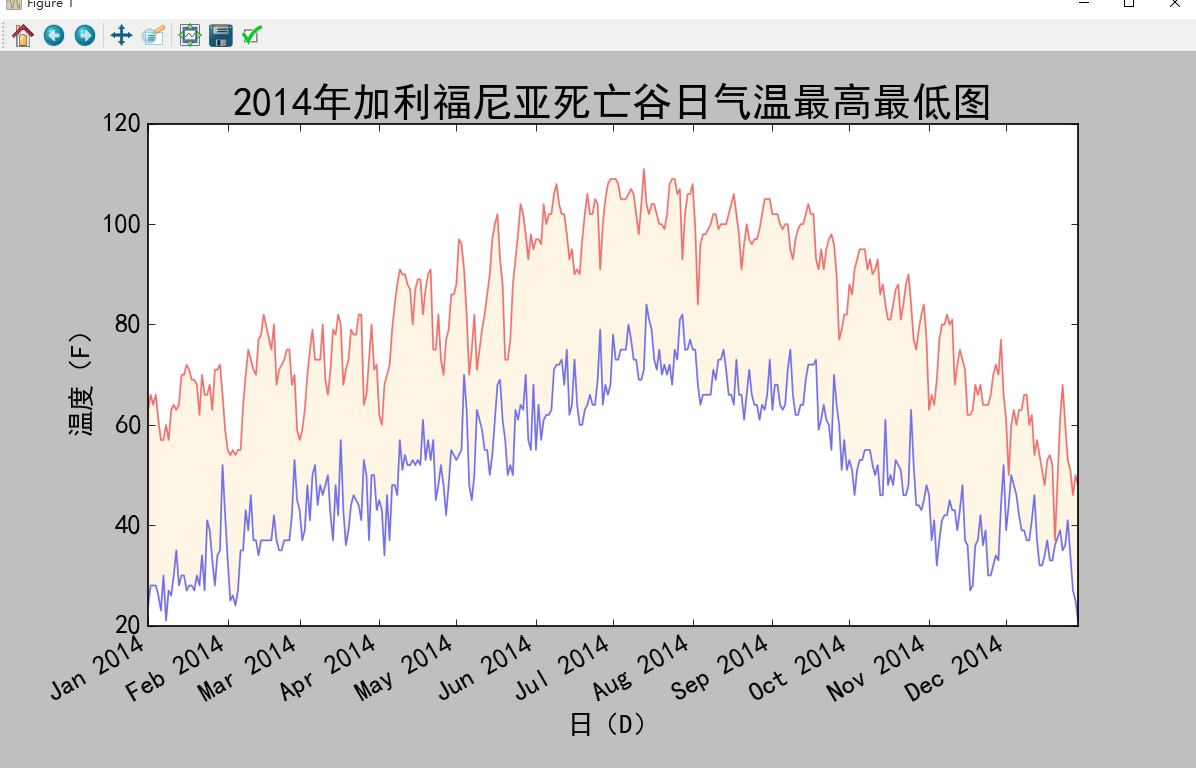
7 制作世界人口地图:JSON格式
7.1 需求描述
下载json格式的人口数据,并使用json模块来处理。
7.2 源码
json数据population_data.json部分信息

countries.py
from pygal.maps.world import COUNTRIESfor country_code in sorted(COUNTRIES.keys()): print(country_code, COUNTRIES[country_code])
countries_codes.py
from pygal.maps.world import COUNTRIESdef get_country_code(country_name): """Return the Pygal 2-digit country code for the given country.""" for code, name in COUNTRIES.items(): if name == country_name: return code # If the country wasn't found, return None. returnprint(get_country_code('Thailand'))# print(get_country_code('Andorra'))
americas.py
import pygalwm =pygal.maps.world.World()wm.title = 'North, Central, and South America'wm.add('North America', ['ca', 'mx', 'us'])wm.add('Central America', ['bz', 'cr', 'gt', 'hn', 'ni', 'pa', 'sv'])wm.add('South America', ['ar', 'bo', 'br', 'cl', 'co', 'ec', 'gf', 'gy', 'pe', 'py', 'sr', 'uy', 've'])wm.add('Asia', ['cn', 'jp', 'th'])wm.render_to_file('americas.svg')
world_population.py
#conding = utf-8import jsonfrom matplotlib import pyplot as pltimport matplotlib as mplfrom country_codes import get_country_codeimport pygalfrom pygal.style import RotateStylefrom pygal.style import LightColorizedStyle# 解决中文乱码问题mpl.rcParams['font.sans-serif']=['SimHei']mpl.rcParams['axes.unicode_minus']=False# 加载json数据filename='population_data.json'with open(filename) as f: pop_data = json.load(f) # print(pop_data[1])# 创建一个包含人口的字典cc_populations={}# cc1_populations={}# 打印每个国家2010年的人口数量for pop_dict in pop_data: if pop_dict['Year'] == '2010': country_name = pop_dict['Country Name'] population = int(float(pop_dict['Value'])) # 字符串数值转化为整数 # print(country_name + ":" + str(population)) code = get_country_code(country_name) if code: cc_populations[code] = population # elif pop_dict['Year'] == '2009': # country_name = pop_dict['Country Name'] # population = int(float(pop_dict['Value'])) # 字符串数值转化为整数 # # print(country_name + ":" + str(population)) # code = get_country_code(country_name) # if code: # cc1_populations[code] = populationcc_pops_1,cc_pops_2,cc_pops_3={},{},{}for cc,pop in cc_populations.items(): if pop <10000000: cc_pops_1[cc]=pop elif pop<1000000000: cc_pops_2[cc]=pop else: cc_pops_3[cc]=pop# print(len(cc_pops_1),len(cc_pops_2),len(cc_pops_3))wm_style = RotateStyle('#336699',base_style=LightColorizedStyle)wm =pygal.maps.world.World(style=wm_style)wm.title = '2010年世界各国人口统计图'wm.add('0-10m', cc_pops_1)wm.add('10m-1bm',cc_pops_2)wm.add('>1bm',cc_pops_3)# wm.add('2009', cc1_populations)wm.render_to_file('world_populations.svg')
7.3 生成结果
countries.py
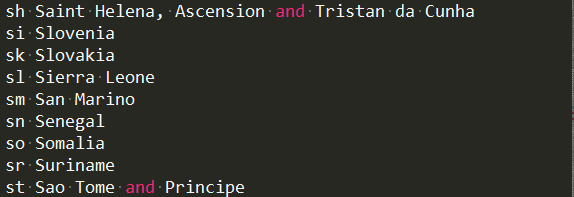
world_population.py
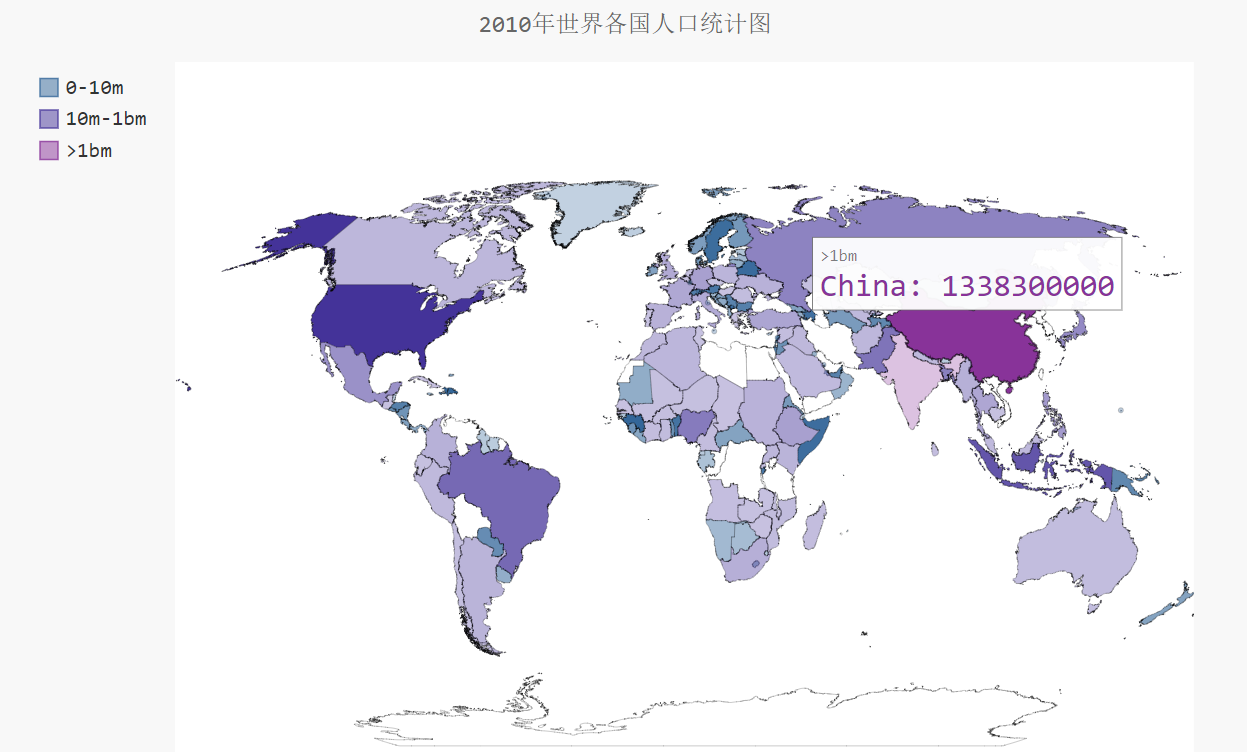
8 Pygal可视化github仓库
8.1 需求描述
调用web API对GitHub数据仓库进行可视化展示:https://api.github.com/search/repositories?q=language:python&sort=stars
8.2 源码
python_repos.py
# coding=utf-8import requestsimport pygalfrom pygal.style import LightColorizedStyle as LCS, LightenStyle as LS# Make an API call, and store the response.url = 'https://api.github.com/search/repositories?q=language:python&sort=stars'r = requests.get(url)print("Status code:", r.status_code) # 查看请求是否成功,200表示成功response_dict = r.json()# print(response_dict.keys())print("Total repositories:", response_dict['total_count'])# Explore information about the repositories.repo_dicts = response_dict['items']print("Repositories returned:",len(repo_dicts))# 查看项目信息# repo_dict =repo_dicts[0]# print('\n\neach repository:')# for repo_dict in repo_dicts:# print("\nName:",repo_dict['name'])# print("Owner:",repo_dict['owner']['login'])# print("Stars:",repo_dict['stargazers_count'])# print("Repository:",repo_dict['html_url'])# print("Description:",repo_dict['description'])# 查看每个项目的键# print('\nKeys:',len(repo_dict))# for key in sorted(repo_dict.keys()):# print(key)names, plot_dicts = [], []for repo_dict in repo_dicts: names.append(repo_dict['name']) plot_dicts.append(repo_dict['stargazers_count'])# 可视化my_style = LS('#333366', base_style=LCS)my_config = pygal.Config() # Pygal类Config实例化my_config.x_label_rotation = 45 # x轴标签旋转45度my_config.show_legend = False # show_legend隐藏图例my_config.title_font_size = 24 # 设置图标标题主标签副标签的字体大小my_config.label_font_size = 14my_config.major_label_font_size = 18my_config.truncate_label = 15 # 较长的项目名称缩短15字符my_config.show_y_guides = False # 隐藏图表中的水平线my_config.width = 1000 # 自定义图表的宽度chart = pygal.Bar(my_config, style=my_style)chart.title = 'Most-Starred Python Projects on GitHub'chart.x_labels = nameschart.add('', plot_dicts)chart.render_to_file('python_repos.svg')
8.3 生成结果
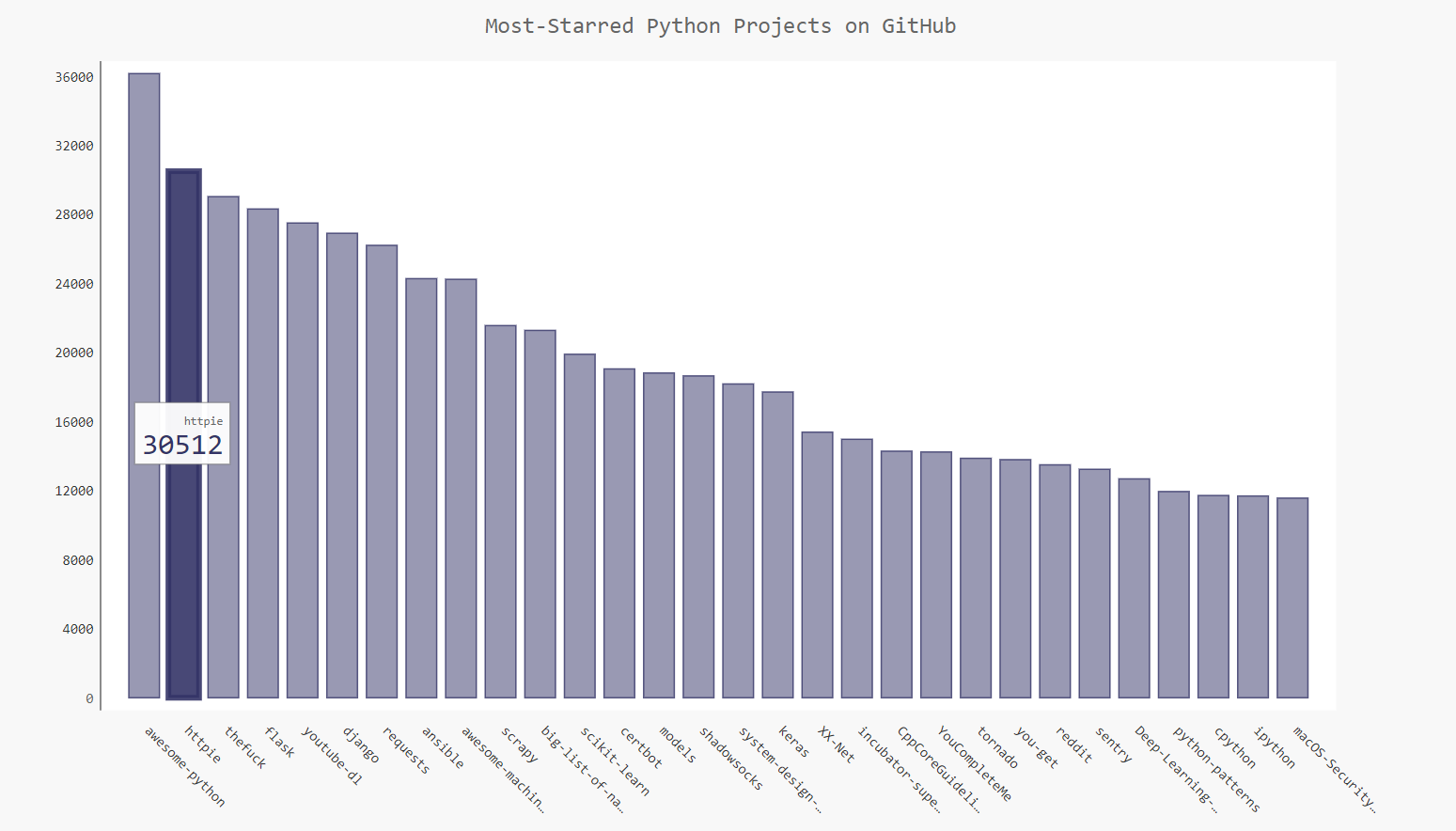
9 参考文献
1 matplotlib官网
2 天气数据官网
3 实验数据下载
4 google charts
5 Plotly
6 Jpgraph
阅读全文
0 0
- 【Matplotlib】数据可视化实例分析
- python数据分析之数据可视化matplotlib
- python中数据分析数据可视化作图matplotlib
- Python数据挖掘学习04---matplotlib数据可视化分析
- 【数据可视化】 之 Matplotlib
- matplotlib数据可视化知识点
- Matplotlib数据可视化
- matplotlib实现数据可视化
- 数据可视化之一matplotlib
- python—matplotlib数据可视化实例注解系列-----之横条图
- python—matplotlib数据可视化实例注解系列-----之箱状图
- python—matplotlib数据可视化实例注解系列-----之柱状图
- python数据分析(十四)-matplotlib 绘图与可视化
- Python-Matplotlib(4) 基于真实数据集的可视化分析
- python—matplotlib数据可视化实例注解系列-----设置标注字体样式(matplotlib颜色库)
- 数据可视化-Python之Matplotlib
- matplotlib数据可视化入门-python
- 数据可视化matplotlib的应用
- centos 装 mongodb
- 相机对焦
- 安卓-ListView侧滑(二)之SwipeMenuListView添加menu.getViewType()属性控制是否侧滑
- windows/Linux修改oracle数据库用户密码
- SQLite 3 导入导出成txt或csv操作
- 【Matplotlib】数据可视化实例分析
- winform 图片按钮
- eclipse 创建maven 项目 动态web工程完整示例(亲测,很好)
- JS传到后台出现中文乱码解决办法
- hdu 1874
- ACM/ICPC WORLD FINAL 2015 A题
- Java反射获取private属性和方法(子类,父类,祖先....)
- vuejs学习 第一记 vuecli
- 每天学习30分钟新知识之html教程1


